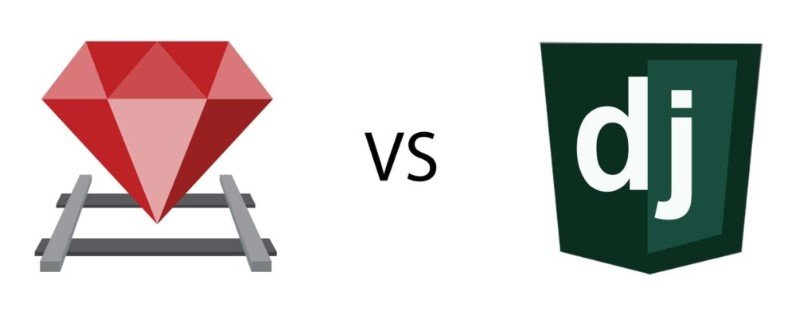Django and Ruby on Rails have so many admirers and both these frameworks seem perfect for web development. However, we have our favorite tricky question for you – how will you choose the best one?
These frameworks have several things in common. For example, they both are dynamically typed and object-oriented solutions. Their performance is specific for each project. Both Rails and Django are excellent choices but if you are striving to decide between the two, this post contains some essential things to consider that will help you make the right choice.

We have recently compared Django with other famous frameworks (for example, Django vs Flask). Now is the time to compare it with Ruby on Rails. But first, let’s dive into the basic facts and frameworks’’ description.
Contents
What is Django?
We know Django as a popular open-source framework, built with Python. It offers numerous outstanding modules to help developers save their precious time and avoid repeating a certain process over and over again. What makes it popular? Actually, this excellent free open-source framework is accessible for anyone.
Django was released with the goal of simplifying the process of building database-driven and complex websites. The framework was released in 2005 and nowadays it is widely used all over the world because of the fast development and pragmatic design. Such giants sites as NASA, Mozilla, and Udemy were built with the help of this solution.
What are the benefits of using Django?
- Friendly admin panel
- Numerous plug-ins based on mature software
- Scalability
- The REST (Representational State Transfer) availability
- MVC programming supporting
- Compatibility with operating systems and databases
What are the weak points of the framework?
- Based on Django ORM
- Lack of the ability to handle multiple requests simultaneously
- It is too monolithic
- Tightly-coupled web app components

What is Rails?
Ruby on Rails (RoR) is also a reliable open-source solution for developing in Ruby for the web. The key advantage of RoR is its speed and ease of development. There is no need for developers to go through all of the time-consuming steps of the web development cycle as they can make changes to the apps right away. They often use rails to create sites like the ones you use every single day.
There are two core principles that form the basis of this framework: Convention Over Configuration and DRY (Don’t Repeat Yourself). Ruby on Rails contains many components that allow users to leave comments, make a purchase or to log in easily. Such popular sites as Shopify, Github, and Kickstarter were built on its base.
What are the benefits of using Ruby on Rails?
- Variety of tools and presets
- High-speed development
- Easiness to migrate
- Advanced testing environment
- Active community
What are the drawbacks?
- Low speed of runtime
- Tricky to create API
- Varying standard of documentation
- Lack of flexibility
Well, with all of this in mind, let’s quickly compare these frameworks to understand which one to choose for website development.

Django vs Rails: Defining the Key Differences Between Popular Frameworks
We will not discover continents, but simply take the standard scheme of comparison as the basis, and will determine the distinctive features of both frameworks by several important indicators. So let’s get started.
Let’s start with discussing language
Django uses language widely known as Python (designed and released in 1990). The language emphasizes readability and clarity. It is quite easy to learn and fast to write.
Rails uses Ruby that was released in 1995. This is also an object-oriented and general-purpose language preferred by many developers around the globe. It’s also known for being enjoyable to write. Right, it seems that Rails was created with an emphasis on the real joy of writing it.
Then, let’s compare their architecture
Both web development frameworks have adopted Model-View-Controller (MVC). For Django, it is called Model-View-Template (MVT). MVC and MVT have small differences
MVT represents a database that describes the data structure. Template means a web templating system that amalgamates with Django Template Language (DLT). The controller part is handled by Django itself.
In MVC, the Model denotes the data of the database such as comments, posts, pictures, and so on. ActiveRecord takes care of it. The View covers the data in the HTML template and then sends it to the Controller, Later it is handled by ActiveView. The ActionController connects Model and View and handles all requests.
Let’s also talk about performance and speed
According to the official data, Ruby on Rails is faster than Django by 0.7%. It all because RoR has a rich repository of powerful libraries and plugins to boost the speed and performance of this framework. However, Django also encourages a fast development process and it is a great choice for a web framework.
The performance of both solutions is high just because they leverage modern programming languages while providing the tools to optimize the code.

Usage is also a crucial thing to discuss
Django is your choice if you are looking for a solution that will help in developing complex websites and web apps in less time. It is about efficiency in system administration, scientific programming, data analytics, and manipulation.
RoR also successfully helps in developing database-backend web apps. It provides better usability and freedom to coders. It looks like an ideal choice for meta programming and creating pleasing codes.
Now it’s time to compare UI and stability
Concerning the user interface, both Rails and Django are absolutely the winners. They both propose a high-class experience and allow every application development agency to develop highly-functional websites loaded with outstanding plugins and add-ons.
Stability is also necessary for development. Rails has the ability to juggle it as it allows reusing the code to minimize the dependencies. It also frees developers from additional efforts because of using the Convention over Configuration approach. Python is connected with a more conventional approach. It provides stability by sticking to any proven method to solve problems.
A couple of words about security and installation
The factor of security is an indispensable part of any website or app. Django has gained this feature from Python. It is backed with middlewares. Rails is supported with active records. They both have tools that safeguard apps from SQL injection, cross-site scripting, and so on.
the process of installation in Django is easy and hence. It only takes about a minute to install completely. We can’t say the same words about Ruby on Rails. You will first need to understand what bundles and Gems are. They are installed and then the run Command Gem Install Rails. It finally installs the latest version of the framework.
Finally, let’s remind of ecosystem and community support
Django has an open-source ecosystem. It means that there are many libraries and tools, available to developers. The official documentation looks more than enough for reference if you need an answer to any problem.
The community of Django is about 11K people with more than 4K readymade packages for developers. Rails has a highly active community of 5K people. They have already contributed of Gems with reusable code.
Rails vs Python Django: when is it better to use them?
- To make the long story short, you should go with Django in case you have to use Python-specific libraries. It will suit you if you’re building a machine learning app, and when your team simply prefers to use Python.
- Ruby on Rails is the better choice in case you have an experienced team. The framework requires great development skills which could be even more challenging if you have strict deadlines. RoR will help you to create apps quickly, but do not expect that your developers will learn it quickly.
Make sure, you have evaluated all the benefits of each framework. Pay enough attention to the experience of your team and your requirements when choosing the best solution. Have a good choice!





